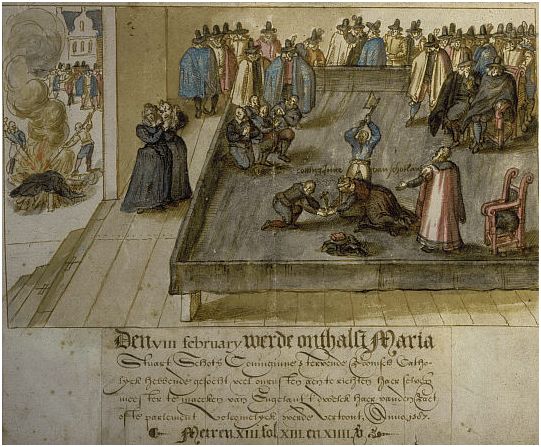What crime was Mary Queen of Scots executed for?

Mary Queen of Scots was deposed from the Scottish throne while imprisoned at Lochleven Castle. She was not brought to trial in Scotland but was implicated in the murder of her husband Lord Darnley particularly as she had married the Earl of Bothwell, generally thought to have perpetrated the crime. When she escaped to England, the English Government wanted her out of the way. They needed an excuse to hold her under house arrest, or better still a reason to execute her, but it was soon recognised that the evidence against her in Scotland was fraudulent. Any trial would implicate the Regency and members of the Scottish Government that had replaced her, which the English Government wanted to support.
Yet Mary remained very dangerous to the English, she was the dynastic heir to the English throne, and, as a Catholic, was likely to reverse the hard won English reformation. If the English Government, wanted justification to execute her, they needed evidence of a crime that she had committed in England. Her trial at Fotheringhay found her guilty of treason for having supported the Babington plot to murder Elizabeth and to place her on the English throne in Elizabeth’s place. Evidence for this came from messages written in code by Mary’s secretaries, which were deciphered by Thomas Phelippes on behalf of William Cecil, the English Secretary of State, after Mary’s communication system had been infiltrated. There can be no doubt that Mary agreed to support the Babington plot, but she argued that her secretaries had acted without her authority. As they were extremely loyal, and were not permitted to give evidence at her trial, she could claim that there was no evidence to disprove her arguments. Furthermore, the plot itself

was probably a fiction created by Cecil’s and Walsingham’s double agents. Anthony Babington had been encouraged to manage a plot that had been begun by Gilbert Gifford, who was enticed into becoming Cecil’s agent and into managing Mary’s communication system for the sole purpose of snaring her. Gifford’s activities allowed all Mary’s correspondence to be seen by the English authorities. Although the plot reputedly had the support of the Spanish, there is no evidence that they were involved. It thus had no realistic chance of success. Yet Elizabeth was shocked that Mary was expressing her undying loyalty, while at the same time supporting a plot to replace her on the throne.
The weakness in the case against Mary was that she was a head of state of a foreign power, who had not been found guilty of any wrong-doing and was not subject to English law. A Monarch was above the law, and she was never charged with complicity in the murder of her husband, Lord Darnley. Cecil’s argument was that Scotland was an English suzerainty making its monarchs subject to the English. This was an understanding offered in the 14th century by John Balliol in his attempt to claim the Scottish throne ahead of Robert the Bruce. As Bruce had defeated the English and Balliol at Bannockburn in 1314, this was not an argument that stood the test of time, and Balliol was never accepted by the Scots as their King.
Mary’s only motive at the time of Babington’s plot was to gain release from house arrest. At 44, she was old, was not in the know, and had no political ambitions. Although she was found guilty by the conference at Westminster, Elizabeth deferred signing her death warrant, being extremely nervous of public opinion in both Scotland and on the Continent. If James in Scotland had taken a tougher stand, he could have saved his mother’s life, but he had had a taste for being King of Scotland, and only played lip service to seeking her release. Although Elizabeth subsequently signed the warrant under pressure, she always claimed that she had not intended to do so and signed it among a pile of papers. This seems a convenient excuse.

Mary was executed because she was a committed Catholic and was unwilling to subsume her Catholic persona for political convenience. She remained a member of the dogmatically Catholic and powerful Guise family in France. Cecil had already watched Mary Tudor, another committed Catholic, succeed to the English throne by dynastic right, despite the efforts of the Protestant hierarchy to replace her with her Protestant cousin, Lady Jane Grey. Mary Queen of Scots was Elizabeth’s dynastic heir. In Catholic eyes, she was already rightfully queen. (Elizabeth remained illegitimate in Catholic eyes, having been born during the lifetime of Henry VIII’s first wife the Catholic Catherine of Aragon.) Cecil’s solution was to arrange for Mary’s son James VI of Scotland to be brought up as a Protestant, allowing him to inherit the English throne on a wave of Protestant support on Elizabeth’s death.
A fuller account can be found in Robert Stedall’s new book, Mary Queen of Scots’ Downfall – The Life and Murder of Henry, Lord Darnley published by Pen and Sword in November 2017

